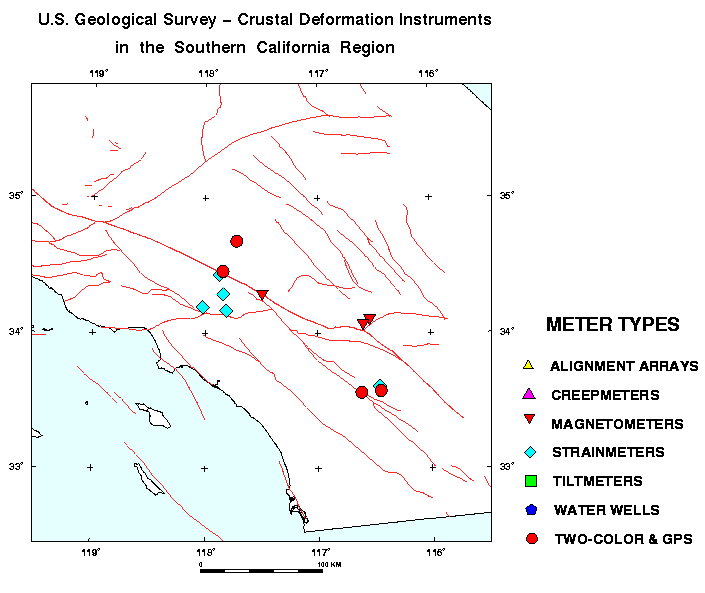Four EDM networks located in Southern California show strain accumulation on the San Andreas fault system in this region.

Maps of the network
The maps of the networks show the location of the baselines in red, the major faults with dark, heavy lines, and other faults with thin lines.
Measurements at Pinon Flat and Pearblossom are made approximately 3 to 4 times per year but the measurements at Anza and at the Buttes are made approximately once per year. Each measurement of strain requires a 3 to 4 person crew to be on-site to run the instrument and set-up the reflectors to make distance measurements on approximately one dozen baselines. Baseline length are range between 2 and 10 km.
Plots of the data
- Plot of strain changes from the Pearblossom network
- Plot of strain changes from the Buttes network
- Plot of strain changes from the Pinon Flat network
- Plot of strain changes from the Anza network
Notes on data plots
In general, the vertical line denotes the time of the 1992 Landers Earthquake.
The error bars represent one standard deviation about the estimate of strain change. The error accounts for the instrument precision of 0.1ppm and the random walk motions of each geodetic monument of approximately 1 mm/sqrt(yr). The date of the Landers earthquake is specified as a reference date and the error grows in time relative to this date.
The secular rates have been removed from the strain data and the rates are noted on the plot.
PEARBLOSSOM: Data starts in late 1980 when measurements were made several times each week. This network straddles the San Andreas fault. The strain changes estimated for the first several years assume that strain changes linearly with time over 2-week intervals. However, since 1985, measurements of the 12 baseline network have been made approximately 3 to 4 times each year. The strain changes that are plotted are reckoned such that parallel strain is extension parallel with the local strike of the San Andreas fault, N65W, normal strain is extension N25E, and shear strain is the tensor shear on a plane parallel with the San Andreas fault. Because the network is highly redundant for estimating the 3 components of the strain tensor, the displacement of the central monument is also estimated as a function of time.
BUTTES: Measurements of this network located north of Pearblossom by 40 Km started in 1991. The strain changes that are plotted are reckoned such that parallel strain is extension parallel with the local strike of the San Andreas fault, N65W, normal strain is extension N25E, and shear strain is the tensor shear on a plane parallel with the San Andreas fault. Because the network is highly redundant for estimating the 3 components of the strain tensor, the displacement of the central monument is also estimated as a function of time.
PINON FLAT: Measurements of this network started in 1986. The strain changes that are plotted are reckoned such that Eee is extension in the east-west direction, Enn is extension in the north-south direction, and Een is tensor shear on either a north-south or east-west plane. Because this network is more-or-less a fan-shaped array rather than a radial network, it is difficult to resolve the contribution of wobble of the central monument from that of changes in strain. So, the results of the strain analysis neglects the motion of the central monument.
ANZA: Measurements of this network that straddles the San Jacinto fault starts in 1988. The strain changes that are plotted are reckoned such that Eee is extension in the east-west direction, Enn is extension in the north-south direction, and Een is tensor shear on either a north-south or east-west plane. Since this network consists of two, radial networks, each with seven baselines, it is difficult to resolve the contribution of wobble of the central monument from that of changes in strain. So, the results of the strain analysis neglects the motion of the central monument.
Secular strain rates
The changes in length of each baseline from each network can be adequately modeled using spatially and temporally uniform strain. The exception to the uniformity in rate of strain are the large, co-seismic changes from the Landers Earthquake in 1992. Tabulated below are the estimates of secular strain and co-seismic strain where all parameters are estimated simultaneously from the data. The errors in secular rate include an estimate of random-walk noise due to wobble of the geodetic monuments.


For more details contact: John Langbein
 Jump to Navigation
Jump to Navigation